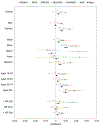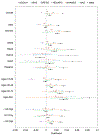Trends in Adult Alcohol Use and Binge Drinking in the Early 21st-Century United States: A Meta-Analysis of 6 National Survey Series
- PMID: 30080258
- PMCID: PMC6364977
- DOI: 10.1111/acer.13859
Trends in Adult Alcohol Use and Binge Drinking in the Early 21st-Century United States: A Meta-Analysis of 6 National Survey Series
Abstract
Background: Recent trends in alcoholic liver disease, alcohol-related emergency room admissions, and alcohol use disorder prevalence as measured by general-population surveys have raised concerns about rising alcohol-related morbidity and mortality in the United States. In contrast, upward trends in per capita alcohol consumption have been comparatively modest.
Methods: To resolve these discordant observations, we sought to examine trends in the prevalence of alcohol use and binge drinking from 6 regularly or periodically administered national surveys using a meta-analytic approach. Annual or periodic prevalence estimates for past-12-month or past-30-day alcohol use and binge drinking were estimated for available time points between the years 2000 and 2016. Estimates were combined in a random-effects regression model in which prevalence was modeled as a log-linear function of time to obtain meta-analytic trend estimates for the full population and by sex, race, age, and educational attainment.
Results: Meta-analysis-derived estimates of average annual percentage increase in the prevalence of alcohol use and binge drinking were 0.30% per year (95% CI: 0.22%, 0.38%) and 0.72% per year (95% CI: 0.46%, 0.98%), respectively. There was substantial between-survey heterogeneity among trend estimates, although there was notable consistency in the degree to which trends have impacted various demographic groups. For example, most surveys found that the changes in prevalence for alcohol use and binge drinking were large and positive for ages 50 to 64 and 65 and up, and smaller, negative, or nonsignificant for ages 18 to 29.
Conclusions: Significant increases in the prevalence of alcohol use and of binge drinking over the past 10 to 15 years were observed, but not for all demographic groups. However, the increase in binge drinking among middle-aged and older adults is substantial and may be driving increasing rates of alcohol-related morbidity and mortality.
Keywords: Adults; Binge Drinking; Epidemiology; Morbidity; Trends.
© 2018 by the Research Society on Alcoholism.
Conflict of interest statement
Figures





References
-
- Askgaard G, Gronbaek M, Kjaer MS, Tjonneland A, Tolstrup JS (2015) Alcohol drinking pattern and risk of alcoholic liver cirrhosis: a prospective cohort study. Journal of hepatology 62:1061–1067. - PubMed
-
- Center for Behavioral Health Statistics and Quality (2017) 2016 National Survey on Drug Use and Health: Methodological summary and definitions, in Series 2016 National Survey on Drug Use and Health: Methodological summary and definitions, Rockville, MD.
-
- Centers for Disease Control and Prevention (2004) Health behavior of adults, 1999–2001, in Series Health behavior of adults, 1999–2001, Centers for Disease Control and Prevention, Hyattsville, MD.
Publication types
MeSH terms
Grants and funding
LinkOut - more resources
Full Text Sources
Other Literature Sources
Miscellaneous

